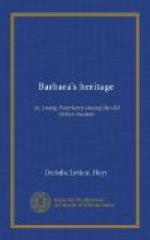Not only this forenoon, but many others, were spent in the Scuola di San Rocco in the study of Tintoretto’s paintings. At first they shuddered at his most vivid representations of poor, sick, wretched beings that cover these immense canvases dedicated to the memory of St. Roch, whose life was devoted to hospital work; then were fascinated by the power that had so ruthlessly portrayed reality. They studied his great Crucifixion,—as a whole, in detailed groups, and then its separate figures,—until they began to realize the magnitude of its conception and rendering. Mr. Sumner had said that nowhere save in Venice can Tintoretto be studied, and all were anxious to understand his work.
At the Academy, close by Titian’s great Assumption of the Virgin, they found Tintoretto’s Miracle of St. Mark, and saw how noble could be, at their best, his composition and drawing, and how marvellous his coloring of sky, architecture, costume, and flesh. They went to the various churches, notably, Santa Maria del Orto, to see good examples of his religious painting; and to the Ducal Palace for his many mythological pictures, and his immense Paradiso. Finally they were happy in feeling that they could comprehend, in some little degree, the spirit of this strange, powerful artist and his work.
One rainy evening, toward the close of their stay in Venice, all sat in the parlor, discussing a most popular novel recently published. It was written in an exceedingly clever manner; indeed, possessed an unusual degree of literary merit. But like many other books then being sent forth, the tale was very sad.
The hero, Richard,—poor, proud, and painfully morbid,—would not believe it possible that the woman whom he passionately loved,—a woman whose life was filled with luxury, and who was surrounded by admirers,—could ever love him; and so he went out from her and all the possibilities of happiness, never to know that her heart was his and might have been had for the asking. The happiness of both lives was wrecked.
“I think no author ought to write such a story,” said Mrs. Douglas, emphatically. “Life holds too much that is sad for us all to justify the expenditure of so much unavailing sympathy. The emotion that cannot work itself out in action takes from moral strength instead of adding to it. It is a pity to use so great literary talent in this way.”
“But do not such things sometimes happen, and is it not a literary virtue to describe real life?” queried Barbara, from her corner amidst the shadows.
“Is it an especially artistic virtue to picture deformity and suffering just because they exist? I acknowledge that a picture or a book may be fine, even great, with such subjects; but is it either as helpful or wholesome as it might have been?” argued Mrs. Douglas.
“Yet in this book the characters of both hero and heroine grow stronger because of their suffering,” suggested Bettina.




